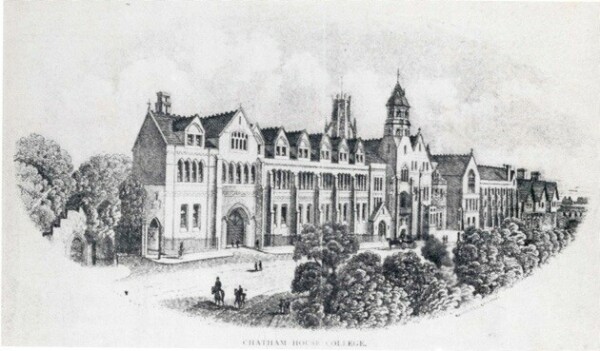Chatham House
The first confirmed mention of the school arises in 1797 as under Dr. William Humble’s care. However, it is distinctly possible that the school had been running for a period prior to that date. There is evidence of the school being situated at No.5 Chatham Street (then called Love Lane) in a premises that was previously a barracks under the ownership of the Townley family estate. This was then taken over by Thomas Whitehead in 1817 and he continued the name of Chatham House when the premises became available. At this time the students had a very different working day to now. Day-boys had to be at school at 5.40am, and were not allowed to go home till 8.20pm, after prayers.
Thomas was succeeded by his son Alfred in 1854, who was then the curate at Saint George’s church, with one of his main introductions being that of the steel pens into the school, which was considered, by both the masters and boys, to be a very serious innovation.
Upon his elevation to becoming vicar of St.Peter’s, Alfred was succeeded as headmaster by Reverend Thomas Stantial in 1864, who in turn was succeeded upon his retirement in 1874 by Reverend Edward Gripper Banks. Under the guidance of ‘Gripper’ Banks the school underwent huge changes, with Rugby football being introduced and Chemistry labs built. The reputation of the school continued to expand and in 1879 the foundation stone for the current ‘red brick’ building was laid, which was then completed in 1882. In 1884 the school grounds were greatly expanded with the purchase, from the Townley Castle Estate, of the seventeen acres adjoining. This established the general shape and grounds of the modern day site. In 1890 Hockey was introduced as a regular school game for the ‘lent’ term.
In 1895 Dr. Banks (as he had become a Doctor of Divinity in 1890) was succeeded by his assistant of ten years Thomas Lace. shortly after, in 1898 Mr Lace retired and was replaced for a short time by Reverend Frederick Tracey, who was in turn succeeded by Arthur Hendry in 1900. Mr Hendry had been a pupil at Chatham House, and took the step of purchasing the freehold of the school property from Dr Banks. This enabled Mr Hendry to make considerable ‘improvements’ to the accommodation of a number of years, with electric light being installed in 1902 and all of the dormitory rooms being fitted with hot and cold water in 1904.
The school’s history is entwined with that of the ‘Ramsgate County School’ which was based on the site that is now Clarendon House. Much of the archive record that we have is of the County school, and as it did eventually take on the mantle of Chatham House we have included it within this site.

